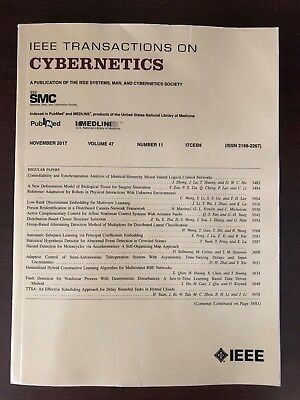基于全身运动规划和神经动力学优化的步态康复外骨骼鲁棒模型预测控制
IF 9.4
1区 计算机科学
Q1 AUTOMATION & CONTROL SYSTEMS
引用次数: 0
摘要
传统的下肢外骨骼(LLEs)及其相应的康复方案很难为不同的患者和场景提供安全、可定制的步态康复训练。因此,本研究提出了一种配备缆索驱动体重支撑(BWS)移动机构的8自由度康复LLE。移动BWS机构被设计为跟随佩戴者并提供预设的支撑力和平衡保护。提出了一种全身运动规划方法,利用迭代零空间投影将步态训练的任务空间轨迹求解为LLE的关节空间轨迹。为了获得更好的控制性能,对人- lle耦合系统的动态参数进行了估计。然后设计了鲁棒模型预测控制(MPC)和干扰观测器相结合的控制方案,以控制系统在轨迹跟踪过程中的动力学不确定性和干扰。在验证实验中,将鲁棒MPC的标称模型离散为二次规划问题,并通过神经动力学优化在线求解。实验结果证明了系统设计和运动规划方法的合理性,以及控制方案的有效性和稳定性。本文章由计算机程序翻译,如有差异,请以英文原文为准。
Robust Model Predictive Control of a Gait Rehabilitation Exoskeleton With Whole Body Motion Planning and Neuro-Dynamics Optimization
Conventional lower limb exoskeletons (LLEs) and their corresponding rehabilitation protocols can hardly provide safe and customizable gait rehabilitation training for different patients and scenarios. Thus, this study presents an 8-DoF rehabilitation LLE equipped with a cable-driven body weight support (BWS) mobile mechanism. The mobile BWS mechanism is designed to follow the wearer and offer preset supportive forces and balance protection. A whole body motion planning approach is proposed, wherein iterative null-space projection is employed to solve the task-space trajectories of gait training into the joint-space trajectories of the LLE. For better control performance, dynamic parameters of the human-LLE coupling system are estimated. A control scheme combining robust model predictive control (MPC) and disturbance observer is then designed to manipulate the system against dynamics uncertainty and disturbance during trajectory tracking. In the validation experiments, the nominal model of robust MPC is discretized into quadratic programming problems and solved online by the neuro-dynamics optimization. The experimental results demonstrate the rationality of our system design and motion planning method as well as the effectiveness and stability of the control scheme.
求助全文
通过发布文献求助,成功后即可免费获取论文全文。
去求助
来源期刊

IEEE Transactions on Cybernetics
COMPUTER SCIENCE, ARTIFICIAL INTELLIGENCE-COMPUTER SCIENCE, CYBERNETICS
CiteScore
25.40
自引率
11.00%
发文量
1869
期刊介绍:
The scope of the IEEE Transactions on Cybernetics includes computational approaches to the field of cybernetics. Specifically, the transactions welcomes papers on communication and control across machines or machine, human, and organizations. The scope includes such areas as computational intelligence, computer vision, neural networks, genetic algorithms, machine learning, fuzzy systems, cognitive systems, decision making, and robotics, to the extent that they contribute to the theme of cybernetics or demonstrate an application of cybernetics principles.
 求助内容:
求助内容: 应助结果提醒方式:
应助结果提醒方式:


